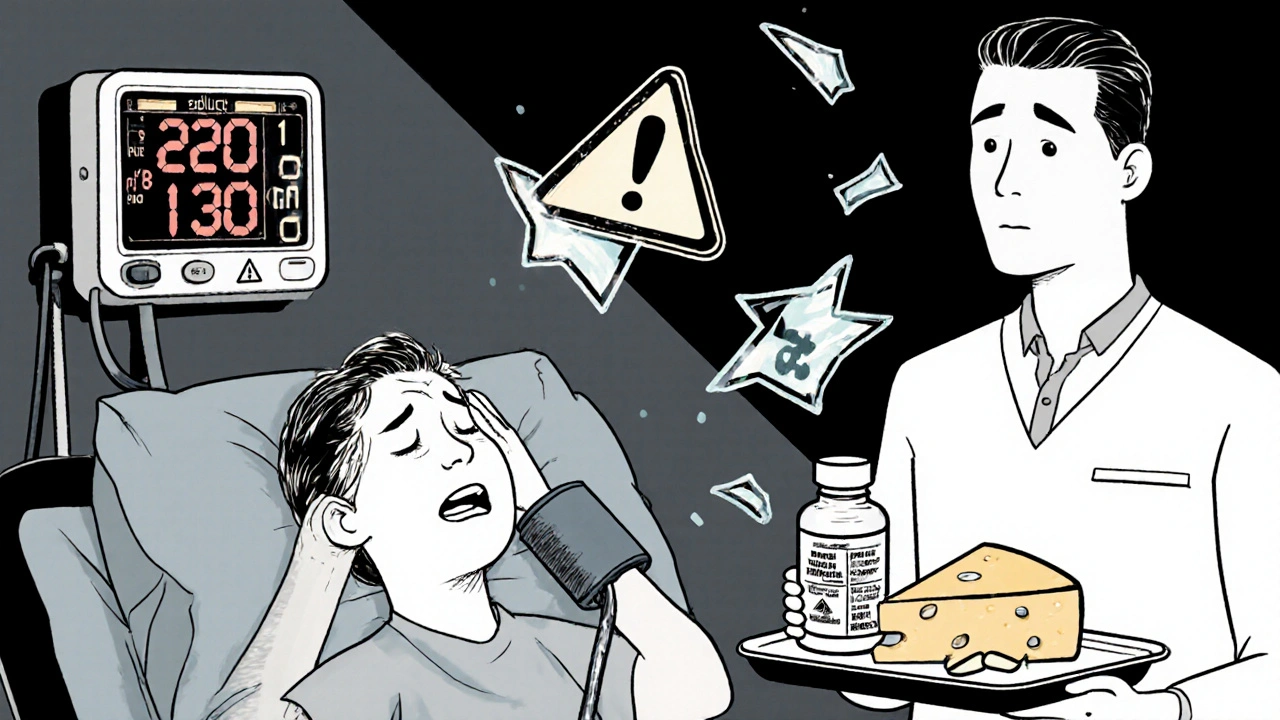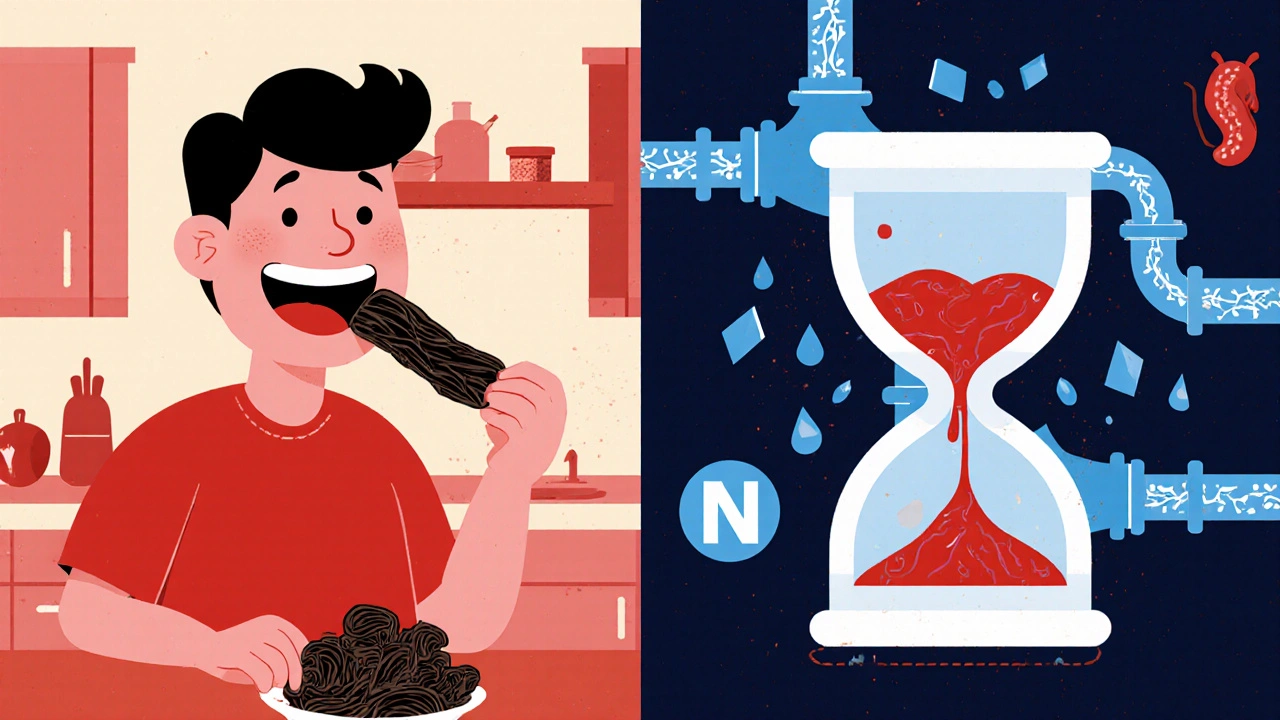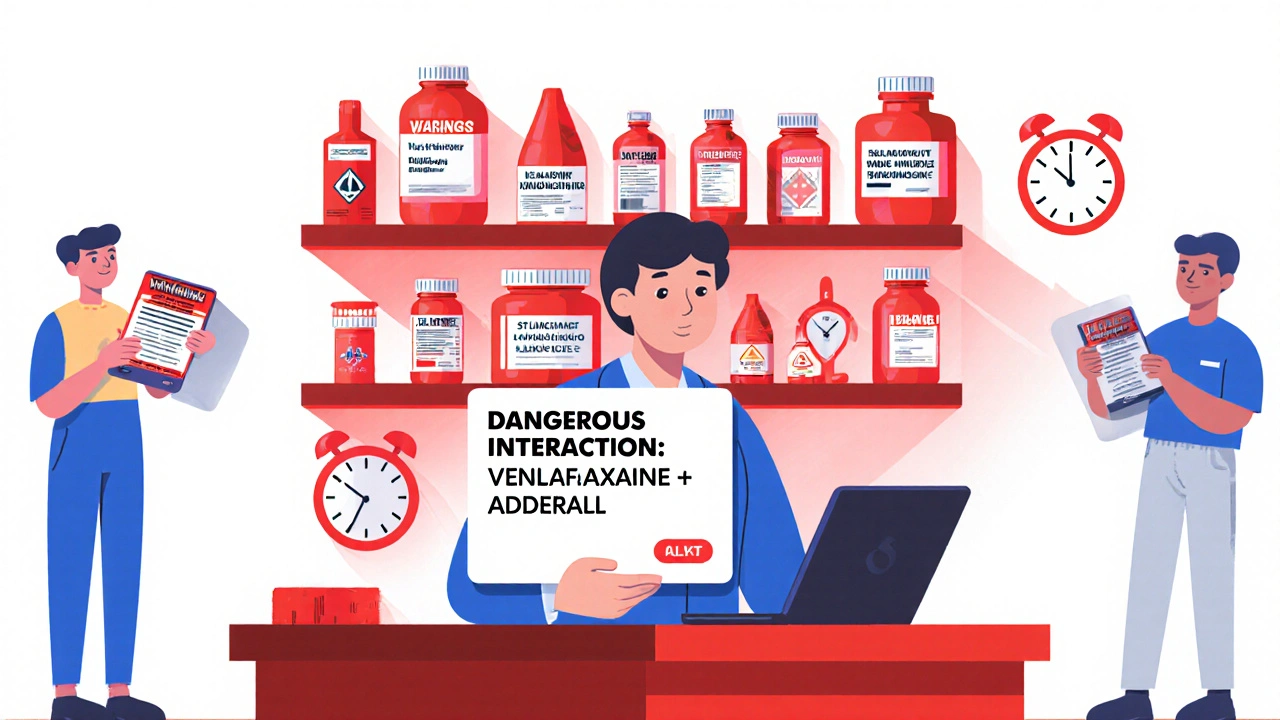Severe Hypertensive Crisis from Drug Interactions and Reactions
 Oct, 28 2025
Oct, 28 2025
Hypertensive Crisis Risk Checker
Check Your Medication Safety
This tool helps identify dangerous drug interactions that could lead to severe hypertensive crisis. Always consult your healthcare provider for medical advice.
Risk Assessment
Important: This tool is for informational purposes only and does not replace professional medical advice. If you experience symptoms of hypertensive crisis (severe headache, blurred vision, chest pain), seek emergency medical attention immediately.
A severe hypertensive crisis isn’t just high blood pressure-it’s a life-threatening surge that can rupture blood vessels, trigger a stroke, or shut down your kidneys in minutes. Most people think of hypertension as a slow-burning problem, something you manage with pills and diet. But when certain drugs collide-whether prescription, over-the-counter, or even something as simple as licorice candy-the result can be a blood pressure spike so extreme it lands you in the ICU.
What Exactly Is a Hypertensive Crisis?
A hypertensive crisis occurs when your systolic pressure climbs above 180 mmHg or your diastolic pressure hits 120 mmHg or higher. It’s not just a number on a monitor-it’s a sign your body’s blood vessels are under catastrophic stress. There are two types: urgency and emergency. Urgency means your pressure is dangerously high but your organs aren’t damaged yet. Emergency means damage is already happening-brain swelling, heart strain, kidney failure, or retinal bleeding. The difference? One can wait hours for treatment. The other needs intervention within minutes.
According to the NCBI Bookshelf (2023), about 22% of all hypertensive emergencies are caused by drug interactions. That’s not rare. It’s common enough that every ER doctor should ask: What are you taking? Not just your prescriptions-your supplements, your cold medicine, your weekend drink.
Drug Interactions That Can Trigger a Crisis
Not all medications are created equal when it comes to blood pressure. Some are silent killers when mixed. Here are the most dangerous combos:
- MAOIs + tyramine-rich foods: Monoamine oxidase inhibitors (MAOIs) like phenelzine or selegiline are used for depression and Parkinson’s. But if you eat aged cheese, cured meats, soy sauce, or draft beer while on them, your body can’t break down tyramine. That leads to a flood of norepinephrine-your blood pressure can rocket to 250 mmHg in under an hour. Case reports show patients waking up with 220/130 after a single slice of cheddar.
- Cocaine + propranolol: Cocaine alone raises blood pressure. Propranolol, a beta-blocker, blocks the heart’s response but leaves blood vessels wide open to cocaine’s vasoconstrictive effects. The result? Unopposed alpha-receptor stimulation. Systolic spikes over 220 mmHg have been documented within 30 minutes.
- Venlafaxine over 300 mg/day: This SNRI antidepressant is fine at lower doses. But above 300 mg daily, it starts acting like a powerful stimulant. Studies show diastolic pressure regularly climbs above 90 mmHg, and in some patients, it triggers full-blown crises. Emergency room data shows 40% more hypertensive events in patients taking venlafaxine with stimulants like Adderall.
- Cyclosporine + calcium channel blockers: Used after organ transplants, cyclosporine causes hypertension in up to half of patients. When combined with drugs like amlodipine, the effect isn’t just additive-it’s unpredictable. Many doctors mistake this for organ rejection and increase immunosuppressants, making the hypertension worse.
- Licorice candy + diuretics: Real licorice (not the black jellybean kind) contains glycyrrhizin, which mimics aldosterone. This causes sodium retention, potassium loss, and fluid overload. One study found patients who ate just 100g of licorice daily for two weeks developed hypokalemia (potassium under 3.5 mmol/L) and systolic pressure above 190 mmHg. It took 14 days after quitting for their BP to normalize.
Why Doctors Miss These Reactions
Here’s the scary part: in 65% of hypertensive crisis cases, doctors don’t even check for drug interactions. A 2015 review in the European Journal of Pharmacology found that only 35% of ER physicians routinely ask about all medications-prescription, OTC, or herbal.
Patients aren’t to blame entirely. Many don’t realize that Advil Cold & Sinus, pseudoephedrine, or even St. John’s Wort can be dangerous. A 2021 survey in the Journal of Patient Safety found that 68% of people who had a hypertensive crisis had mentioned unexplained headaches or blurred vision to their doctors-but only 22% had their meds reviewed.
Even labeling is flawed. A 2022 analysis in JAMA Internal Medicine found that 78% of high-risk medications have inadequate warnings about hypertensive risks, especially for off-label uses. The FDA now requires black box warnings on MAOIs, but over-the-counter decongestants? Only 12% of them carry any meaningful hypertension warning, according to Consumer Reports (2023).

How to Spot the Warning Signs Early
Don’t wait for a blood pressure reading to tell you something’s wrong. These symptoms often come before the spike:
- Sudden, severe headache (often at the back of the head)
- Blurred vision or seeing spots
- Chest pain or pressure
- Shortness of breath
- Nausea or vomiting
- Confusion or dizziness
- Nosebleeds (unusual for healthy people)
If you’re on any of the high-risk medications listed above and you feel any of these, don’t wait. Go to the ER. Don’t call your doctor first. Don’t take another pill. Time is tissue.
What Happens in the ER?
Not all hypertensive crises are treated the same. The drug causing it determines the rescue plan:
- MAOI-tyramine crisis: IV phentolamine (5-15 mg) works in 20 minutes with 92% success. Labetalol is a good second choice.
- Cyclosporine-induced: Calcium channel blockers like nifedipine or amlodipine are preferred. Avoid ACE inhibitors-they can worsen kidney stress.
- Cocaine or stimulant-related: Benzodiazepines (like lorazepam) calm the nervous system. Avoid beta-blockers alone-they can make it worse.
- Mineralocorticoid excess (from licorice or steroids): Stop the trigger. Use spironolactone to block aldosterone effects. Potassium replacement is critical.
There’s no one-size-fits-all. That’s why knowing the exact drug involved is more important than the number on the monitor.

Prevention Is Possible-Here’s How
You don’t have to live in fear. Prevention is simple if you know what to look for:
- Always tell every doctor you see-every time-what you’re taking. Include supplements, herbal teas, and OTC meds. Write it down. Bring the bottles.
- If you’re on an MAOI, avoid tyramine. No aged cheese, soy sauce, tap beer, cured meats, or fermented foods. Use the MAOI Diet Helper app-it improved adherence by 78% in a Mayo Clinic study.
- Ask your pharmacist if your new prescription interacts with anything you’re already taking. They’re trained for this.
- Know your dose limits. Venlafaxine above 225 mg/day is now classified as high risk. If you’re on it, get your BP checked every 3 months.
- Check your licorice. If you eat black licorice regularly, stop. Even one piece a day can be enough to trigger problems.
- Use the new FDA-approved decision-support tools. Many hospitals now have AI systems that flag dangerous interactions in real time when a prescription is entered. Ask if your pharmacy uses one.
The Bigger Picture: Why This Is Getting Worse
The problem isn’t going away-it’s accelerating. Antidepressant prescriptions are rising 13% each year. Weight-loss drugs like phentermine are now available without a prescription in some states. Older adults are on 8-10 medications at once. The American Heart Association estimates drug-induced hypertensive crises cost $2.3 billion a year in avoidable ER visits and hospital stays.
Research presented at the 2023 AHA Scientific Sessions shows genetic testing can now identify people with CYP2D6 enzyme mutations who metabolize certain antidepressants dangerously slowly. These patients have a 3.2 times higher risk of crisis. This isn’t science fiction-it’s available now.
The NIH is testing a new AI system called the Hypertension Interaction Alert System that predicts severe reactions with 92% accuracy by analyzing 15,000+ known drug combos. It’s not in every hospital yet-but it will be.
For now, your best defense is knowledge. Know your meds. Know your risks. Speak up. A hypertensive crisis doesn’t come with a warning label you can read-it comes with a silent, ticking clock. Don’t wait for the alarm to go off.
Can over-the-counter cold medicine cause a hypertensive crisis?
Yes. Decongestants like pseudoephedrine and phenylephrine are powerful vasoconstrictors. They can raise systolic blood pressure by 10-20 mmHg in just one dose. If you’re on MAOIs, SSRIs, or have untreated hypertension, even a single tablet can trigger a crisis. Always check labels for "decongestant" or "for nasal congestion"-and avoid them if you’re on high-risk medications.
How long after stopping an MAOI is it safe to take another antidepressant?
It depends on the MAOI. For reversible ones like moclobemide, 24 hours may be enough. For irreversible ones like phenelzine or tranylcypromine, you need 4-5 weeks. The American Heart Association recommends 2 weeks, but European guidelines are stricter. Never rush this. A single dose of an SSRI too soon can cause serotonin syndrome or a hypertensive emergency.
Is licorice really dangerous for blood pressure?
Real licorice (Glycyrrhiza glabra) contains glycyrrhizin, which mimics aldosterone and causes sodium retention, potassium loss, and fluid buildup. Eating just 100g daily for two weeks can cause systolic pressure to rise above 190 mmHg and potassium to drop below 3.5 mmol/L. Most licorice candy in the U.S. is flavored with anise and is safe-but always check the ingredients. If it says "licorice extract," avoid it.
Can I still take pain relievers like ibuprofen if I have high blood pressure?
NSAIDs like ibuprofen and naproxen can raise blood pressure by 3-5 mmHg on average-and up to 10 mmHg in people already hypertensive. They also reduce the effectiveness of many blood pressure medications. Acetaminophen is safer for occasional use, but don’t exceed 3,000 mg/day. If you’re on antihypertensives, ask your doctor before taking NSAIDs regularly.
Why does venlafaxine cause high blood pressure at higher doses?
Venlafaxine blocks reuptake of serotonin and norepinephrine. At doses below 150 mg/day, it’s mostly serotonin-focused. Above 225 mg/day, it strongly affects norepinephrine, which is a potent vasoconstrictor. This shifts it from a mild antidepressant to a stimulant-like drug. Studies show diastolic pressure consistently exceeds 90 mmHg at doses above 300 mg/day, with some patients developing full hypertensive emergencies.

KC Liu
October 28, 2025 AT 18:07So let me get this straight - the FDA requires black box warnings on MAOIs but not on pseudoephedrine in Advil Cold & Sinus? That’s not negligence, that’s corporate lobbying with a side of medical malpractice. I’ve seen ER docs dismiss ‘over-the-counter’ meds like they’re candy from a vending machine. Meanwhile, the real crisis is that Big Pharma profits more from ER visits than from prevention. Wake up, people - your ‘safe’ meds are being weaponized by profit margins.
Shanice Alethia
October 30, 2025 AT 09:09OMG I KNEW IT. My cousin took Zyrtec-D and ended up in the ICU with a 230/140 reading - and the doctor just said ‘maybe you’re stressed.’ STRESSED?! He was on an SSRI and took a decongestant that didn’t even have a warning on the box! This is a cover-up. The pharmaceutical industry doesn’t want you to know how many of these drugs are ticking time bombs. I’ve been screaming this for years. No one listens. Until someone dies. Then they write a blog post like this and pat themselves on the back.
shridhar shanbhag
October 30, 2025 AT 11:58Thank you for sharing this. As someone from India where polypharmacy is common - especially among elderly patients managing diabetes, hypertension, and arthritis - this is critical. Many patients take Ayurvedic supplements alongside Western meds without telling their doctors. Licorice root is used in traditional medicine for digestion, but no one warns them about the blood pressure risk. I now include a ‘medication and supplement checklist’ in every consultation. Small steps, but they save lives. Please keep spreading awareness.
John Dumproff
October 30, 2025 AT 14:33I just want to say - if you’re reading this and you’re on any of these meds, you’re not alone. I was on venlafaxine at 300mg and didn’t realize my headaches were a red flag. I thought it was just stress. It took a near-miss ER visit for my pharmacist to catch it. You don’t have to be a medical expert to protect yourself. Just ask: ‘Could this hurt me?’ And then ask again. And again. Your body speaks. Listen. You deserve to be safe.
William Cuthbertson
November 1, 2025 AT 00:17There’s a profound philosophical tension here: modern medicine’s obsession with quantification - the systolic number, the diastolic reading - versus the lived, embodied reality of the patient. We treat blood pressure like a spreadsheet cell, when in truth it’s the pulse of a human system strained by pharmacological collisions we barely understand. The real tragedy isn’t the crisis itself - it’s that we’ve outsourced vigilance to algorithms and labels, while abandoning the sacred ritual of the patient-doctor dialogue. If your doctor doesn’t ask what you’re taking - not just your prescriptions, but your tea, your candy, your ‘natural’ remedies - then you’re not being cared for. You’re being processed.
Eben Neppie
November 2, 2025 AT 02:37Correction: The FDA does require black box warnings on MAOIs - correct. But the claim that ‘only 12% of OTC decongestants carry meaningful hypertension warnings’ is misleading. The FTC mandates that all OTC products list active ingredients. The failure is not labeling - it’s consumer literacy. If you don’t know what pseudoephedrine is, you shouldn’t be taking it. The onus is on the patient to read labels. Pharmacists are trained to counsel - if they didn’t, that’s a systemic failure, not a regulatory one. This article confuses ignorance with malice. Know your meds. Period.
Hudson Owen
November 3, 2025 AT 05:12I appreciate the depth of this post. As someone who has witnessed a family member suffer a hypertensive emergency triggered by an interaction between an SSRI and an OTC sleep aid, I can attest that the silence around these risks is deafening. The medical system often treats hypertension as a chronic condition to be managed - not as a potential acute catastrophe fueled by unseen interactions. I now carry a laminated card in my wallet listing every medication and supplement I take. It’s not dramatic - it’s necessary. I urge everyone to do the same. Knowledge isn’t power here - it’s survival.
Bryan Heathcote
November 5, 2025 AT 01:01Wait - so if I eat licorice candy and take a diuretic, I could drop my potassium to dangerous levels? That’s wild. I’ve been eating those black licorice twists every day for years. I thought it was just a flavor thing. I’m going to check the label right now. Thanks for the heads-up - I didn’t even know there was a difference between real licorice and anise-flavored stuff. This is the kind of info you wish you’d heard before it was too late.